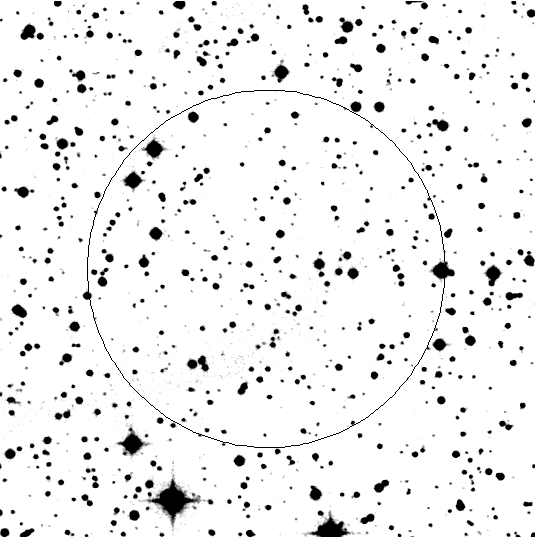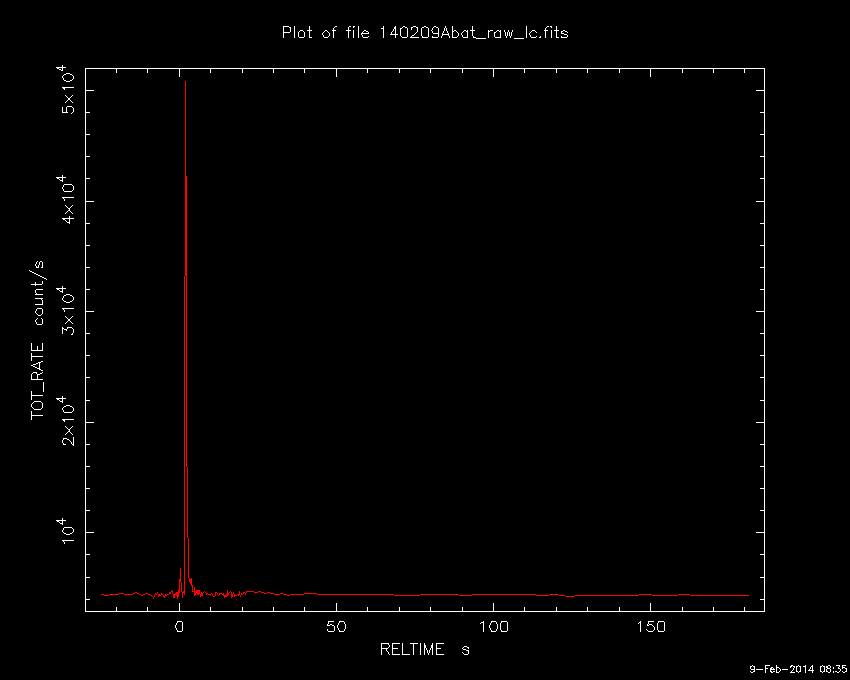(All information courtesy of the instrument teams.)
![]() Previous IAU Circulars
Previous IAU Circulars
TITLE: GCN/SWIFT NOTICE
NOTICE_DATE: Sun 09 Feb 14 07:31:19 UT
NOTICE_TYPE: Swift-BAT GRB Position
TRIGGER_NUM: 586071, Seg_Num: 0
GRB_RA: 81.335d {+05h 25m 20s} (J2000),
81.565d {+05h 26m 16s} (current),
80.519d {+05h 22m 05s} (1950)
GRB_DEC: +32.477d {+32d 28' 37"} (J2000),
+32.489d {+32d 29' 19"} (current),
+32.433d {+32d 25' 59"} (1950)
GRB_ERROR: 3.00 [arcmin radius, statistical only]
GRB_INTEN: 1709 [cnts] Image_Peak=137 [image_cnts]
TRIGGER_DUR: 0.512 [sec]
TRIGGER_INDEX: 124 E_range: 25-100 keV
BKG_INTEN: 18038 [cnts]
BKG_TIME: 27044.37 SOD {07:30:44.37} UT
BKG_DUR: 8 [sec]
GRB_DATE: 16697 TJD; 40 DOY; 14/02/09
GRB_TIME: 27057.88 SOD {07:30:57.88} UT
GRB_PHI: -159.53 [deg]
GRB_THETA: 44.86 [deg]
SOLN_STATUS: 0x20000003
RATE_SIGNIF: 15.77 [sigma]
IMAGE_SIGNIF: 9.74 [sigma]
MERIT_PARAMS: +1 +0 +0 -1 +2 +0 -5 +1 +52 +0
SUN_POSTN: 322.87d {+21h 31m 28s} -14.67d {-14d 39' 55"}
SUN_DIST: 121.86 [deg] Sun_angle= -7.9 [hr] (East of Sun)
MOON_POSTN: 77.85d {+05h 11m 23s} +19.28d {+19d 16' 46"}
MOON_DIST: 13.62 [deg]
MOON_ILLUM: 74 [%]
GAL_COORDS: 174.67, -1.75 [deg] galactic lon,lat of the burst (or transient)
ECL_COORDS: 82.60, 9.26 [deg] ecliptic lon,lat of the burst (or transient)
COMMENTS: SWIFT-BAT GRB Coordinates.
COMMENTS: This is a rate trigger.
COMMENTS: A point_source was found.
COMMENTS: This does not match any source in the on-board catalog.
COMMENTS: This does not match any source in the ground catalog.
COMMENTS: This is a GRB.
COMMENTS: This trigger occurred at longitude,latitude = 287.19,8.87 [deg].
COMMENTS:
COMMENTS: NOTE: This BAT event is temporally(1.0<100sec) coincident with the FERMI_GBM event (trignum=413623861).

TITLE: GCN/FERMI NOTICE
NOTICE_DATE: Sun 09 Feb 14 07:31:25 UT
NOTICE_TYPE: Fermi-GBM Flight Position
RECORD_NUM: 48
TRIGGER_NUM: 413623861
GRB_RA: 83.533d {+05h 34m 08s} (J2000),
83.778d {+05h 35m 07s} (current),
82.668d {+05h 30m 40s} (1950)
GRB_DEC: +39.183d {+39d 10' 60"} (J2000),
+39.192d {+39d 11' 31"} (current),
+39.150d {+39d 08' 59"} (1950)
GRB_ERROR: 3.67 [deg radius, statistical plus systematic]
GRB_INTEN: 2477 [cnts/sec]
DATA_SIGNIF: 42.20 [sigma]
INTEG_TIME: 0.128 [sec]
GRB_DATE: 16697 TJD; 40 DOY; 14/02/09
GRB_TIME: 27058.23 SOD {07:30:58.23} UT
GRB_PHI: 118.00 [deg]
GRB_THETA: 70.00 [deg]
DATA_TIME_SCALE: 0.1280 [sec]
HARD_RATIO: 0.56
LOC_ALGORITHM: 3 (version number of)
MOST_LIKELY: 69% GRB
2nd_MOST_LIKELY: 19% GRO_J0422_32
DETECTORS: 0,0,0, 0,0,0, 0,0,0, 1,1,0, 0,0,
SUN_POSTN: 322.87d {+21h 31m 28s} -14.67d {-14d 39' 55"}
SUN_DIST: 123.04 [deg] Sun_angle= -8.1 [hr] (East of Sun)
MOON_POSTN: 77.85d {+05h 11m 23s} +19.28d {+19d 16' 46"}
MOON_DIST: 20.56 [deg]
MOON_ILLUM: 74 [%]
GAL_COORDS: 170.05, 3.43 [deg] galactic lon,lat of the burst (or transient)
ECL_COORDS: 84.79, 15.86 [deg] ecliptic lon,lat of the burst (or transient)
COMMENTS: Fermi-GBM Flight-calculated Coordinates.
COMMENTS: This trigger occurred at longitude,latitude = 285.67,17.68 [deg].
COMMENTS:
COMMENTS: NOTE: This GBM event is temporally(1.0<100sec) coincident with the SWIFT_BAT event (trignum=586071).
TITLE: GCN/FERMI NOTICE
NOTICE_DATE: Sun 09 Feb 14 07:31:35 UT
NOTICE_TYPE: Fermi-GBM Flight Position
RECORD_NUM: 60
TRIGGER_NUM: 413623861
GRB_RA: 83.533d {+05h 34m 08s} (J2000),
83.778d {+05h 35m 07s} (current),
82.667d {+05h 30m 40s} (1950)
GRB_DEC: +39.200d {+39d 12' 00"} (J2000),
+39.209d {+39d 12' 31"} (current),
+39.167d {+39d 09' 60"} (1950)
GRB_ERROR: 3.43 [deg radius, statistical plus systematic]
GRB_INTEN: 5261 [cnts/sec]
DATA_SIGNIF: 174.30 [sigma]
INTEG_TIME: 0.512 [sec]
GRB_DATE: 16697 TJD; 40 DOY; 14/02/09
GRB_TIME: 27058.23 SOD {07:30:58.23} UT
GRB_PHI: 118.00 [deg]
GRB_THETA: 70.00 [deg]
DATA_TIME_SCALE: 0.5120 [sec]
HARD_RATIO: 0.69
LOC_ALGORITHM: 3 (version number of)
MOST_LIKELY: 74% GRB
2nd_MOST_LIKELY: 16% GRO_J0422_32
DETECTORS: 0,0,0, 0,0,0, 0,0,0, 1,1,0, 0,0,
SUN_POSTN: 322.87d {+21h 31m 28s} -14.67d {-14d 39' 55"}
SUN_DIST: 123.03 [deg] Sun_angle= -8.1 [hr] (East of Sun)
MOON_POSTN: 77.85d {+05h 11m 24s} +19.28d {+19d 16' 46"}
MOON_DIST: 20.58 [deg]
MOON_ILLUM: 74 [%]
GAL_COORDS: 170.04, 3.44 [deg] galactic lon,lat of the burst (or transient)
ECL_COORDS: 84.79, 15.88 [deg] ecliptic lon,lat of the burst (or transient)
COMMENTS: Fermi-GBM Flight-calculated Coordinates.
COMMENTS: This trigger occurred at longitude,latitude = 285.67,17.68 [deg].
COMMENTS:
COMMENTS: NOTE: This GBM event is temporally(1.0<100sec) coincident with the SWIFT_BAT event (trignum=586071).
TITLE: GCN/FERMI NOTICE
NOTICE_DATE: Sun 09 Feb 14 07:31:38 UT
NOTICE_TYPE: Fermi-GBM Ground Position
RECORD_NUM: 58
TRIGGER_NUM: 413623861
GRB_RA: 86.020d {+05h 44m 05s} (J2000),
86.249d {+05h 45m 00s} (current),
85.207d {+05h 40m 50s} (1950)
GRB_DEC: +31.810d {+31d 48' 36"} (J2000),
+31.815d {+31d 48' 55"} (current),
+31.789d {+31d 47' 19"} (1950)
GRB_ERROR: 1.00 [deg radius, statistical only]
DATA_SIGNIF: 209.30 [sigma]
DATA_INTERVAL: 0.512 [sec]
GRB_DATE: 16697 TJD; 40 DOY; 14/02/09
GRB_TIME: 27058.23 SOD {07:30:58.23} UT
GRB_PHI: 123.00 [deg]
GRB_THETA: 76.00 [deg]
E_RANGE: 44.032 - 279.965 [keV]
LOC_ALGORITHM: 4143 (Gnd S/W Version number)
SUN_POSTN: 322.87d {+21h 31m 28s} -14.67d {-14d 39' 55"}
SUN_DIST: 125.86 [deg] Sun_angle= -8.2 [hr] (East of Sun)
MOON_POSTN: 77.85d {+05h 11m 24s} +19.28d {+19d 16' 46"}
MOON_DIST: 14.64 [deg]
MOON_ILLUM: 74 [%]
GAL_COORDS: 177.38, 1.22 [deg] galactic lon,lat of the burst (or transient)
ECL_COORDS: 86.58, 8.42 [deg] ecliptic lon,lat of the burst (or transient)
COMMENTS: Fermi-GBM Ground-calculated Coordinates.
COMMENTS: This Notice was ground-generated -- not flight-generated.
COMMENTS:
COMMENTS: NOTE: This GBM event is temporally(1.0<100sec) coincident with the SWIFT_BAT event (trignum=586071).
TITLE: GCN/SWIFT NOTICE
NOTICE_DATE: Sun 09 Feb 14 07:34:47 UT
NOTICE_TYPE: Swift-BAT GRB Lightcurve
TRIGGER_NUM: 586071, Seg_Num: 0
GRB_RA: 81.335d {+05h 25m 20s} (J2000),
81.565d {+05h 26m 16s} (current),
80.519d {+05h 22m 05s} (1950)
GRB_DEC: +32.477d {+32d 28' 37"} (J2000),
+32.489d {+32d 29' 19"} (current),
+32.433d {+32d 25' 59"} (1950)
GRB_DATE: 16697 TJD; 40 DOY; 14/02/09
GRB_TIME: 27057.88 SOD {07:30:57.88} UT
TRIGGER_INDEX: 124
GRB_PHI: -159.53 [deg]
GRB_THETA: 44.86 [deg]
DELTA_TIME: -70.00 [sec]
TRIGGER_DUR: 0.512 [sec]
SOLN_STATUS: 0x3
RATE_SIGNIF: 15.77 [sigma]
IMAGE_SIGNIF: 9.74 [sigma]
LC_URL: sw00586071000msb.lc
SUN_POSTN: 322.87d {+21h 31m 29s} -14.66d {-14d 39' 52"}
SUN_DIST: 121.86 [deg] Sun_angle= -7.9 [hr] (East of Sun)
MOON_POSTN: 77.88d {+05h 11m 30s} +19.28d {+19d 16' 48"}
MOON_DIST: 13.62 [deg]
MOON_ILLUM: 74 [%]
GAL_COORDS: 174.67, -1.75 [deg] galactic lon,lat of the burst (or transient)
ECL_COORDS: 82.60, 9.26 [deg] ecliptic lon,lat of the burst (or transient)
COMMENTS: SWIFT-BAT GRB Lightcurve.
COMMENTS:
COMMENTS: The next comments were copied from the BAT_POS Notice:
COMMENTS: This is a rate trigger.
COMMENTS: A point_source was found.
COMMENTS: This does not match any source in the on-board catalog.
COMMENTS: This does not match any source in the ground catalog.
COMMENTS: This is a GRB.
COMMENTS: This trigger occurred at longitude,latitude = 287.19,8.87 [deg].

RA(J2000) = 05h 25m 20s Dec(J2000) = +32d 28' 37"with an uncertainty of 3 arcmin (radius, 90% containment, including systematic uncertainty). The BAT light curve showed a multi-peaked structure with a duration of about 5 sec. The peak count rate was ~43000 counts/sec (15-350 keV), at ~2 sec after the trigger.
RA = 05:25:19.034 Dec = +32:29:53.18 (+/- 0.6 arcsec)Calibrated relative to USNO-B1.0, the source fades steadily from R=17.6 in the first r-band image to R=19.4 at 41.1 minutes post-GRB, which identifies it as the likely optical afterglow of this event.
UT mid, Filter Exposure, OT (3 sigma upper limit), object #2
s
07:45:32 none 10*30 > 18.7 18.2+/-0.2
07:58:47 none 10*30 > 18.4 n/d
08:14:05 none 10*30 > 18.3 n/d
RA(J2000) = 05h 25m 18.7s
Dec(J2000) = +32d 29' 17.3"
with an uncertainty of 1.0 arcmin, (radius, sys+stat, 90% containment).
The partial coding was 38%.
RA (J2000): 05h 25m 19.00s Dec(J2000): +32d 29' 56.1"with an uncertainty of 3.0 arcsec (radius, 90% confidence). We cannot determine at the present time whether the source is fading. The position is consistent with that of the optical afterglow reported by Perley (GCN Circ. 15809).
Filter T_start (s) T_stop (s) Exp(s) Mag white 188075 195531 2689 >22.7No correction has been made for the expected Galactic extinction corresponding to E(B-V) = 0.03 in the direction of the burst (Schlegel et al. 1998).